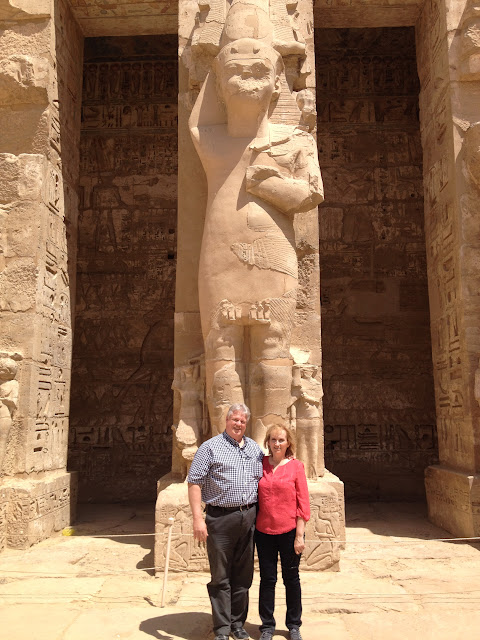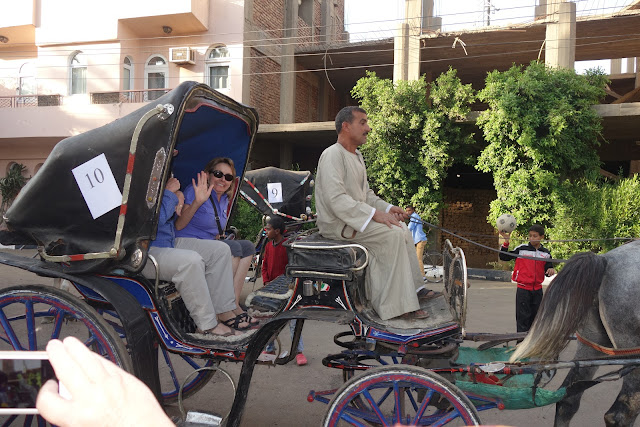The view of the Nile from our ship never disappointed.
The scenery changes every time I peek out out cabin window.
Likewise, the view from our bus window reveals a world completely different from what I imagine Egypt to be.
This is a country of extremes.
The variety of modes of transportation is endless: donkey pulled wagons,
feet,
tractor-ish vehicles,
more donkeys pulling impossibly big loads,
Sometimes a cart was optional.
There were also these little carriages with horses that were sooo thin. I cried for that poor, underfed horse every time I climbed on for a ride.
There were these vans that operated like a bus/taxi (a baxi?). You could hail one and climb aboard and sit in a seat surrounded by strangers.
We saw several of this kind of child-hitchhiker on the back axle of the carriages. Do you think his mommy knows what he's doing? I just held my breathe each time I saw this, sure a kid would slip and be run over.
King of transportation in Egypt seems to be motorcycles. Seeing a lone rider was a rarity.
This was the usual sight: several bodies, smashing together on the bike, usually male.
Sometimes we saw families like this one, all precariously seated on a smallish motorcycle. This cute family pulled up along side our horse-drawn carriage and when the kids saw us, they practically burst with excitement at the sight of non-Egyptians. Seriously, after a few days in Egypt I felt like a rock star. Kids would follow us everywhere, wanting to try out their English, wanting to take pictures, wanting to sell us things, wanting to show us to their family and friends. Stan handed the little girl in front a US dollar as we traveled along, and the four kids giggled with such delight, you would have thought he'd given her a million dollars.
Egyptians cities are a mish-mash of all kinds of structures. Note that semi-done building in the background. We learned that no one finishes their building because your taxes go up when your structure is finished. Unfinished houses pay 1/2 of the tax amount finished houses pay.
There was such a variety of buildings, with areas right in the middle of everything for animals, like the animals stalls above, and this picture below, with feed on the left and a donkey on the right. There were actually several donkeys tied together, I just wasn't able to snap a picture fast enough as we drove by in the bus.
I love the colorful clothing hanging out to dry we saw everywhere. You can see the people are pretty somberly dressed; I think they make up for it with their linens, childrens' clothing, and occasionally, their head scarves.
We saw far too many Egyptian men sitting around smoking from a shisha. There were shops everywhere devoted to these smokers, like we have Starbucks and Starbuck knockoffs in the states.
There were idle Egyptian men everywhere. Egyptian economy has been decimated by the dramatic drop in tourism.
Scenes from the bus.
Today we are heading to the Valley of the Kings, that amazing resting place of King Tut, a whole bunch of Ramesses Pharaohs (Ramesses I-XI), and a large number of other Pharaohs. Just because you own a tomb in Valley of the Kings did not mean you were buried here. A number of Pharaohs ended up being buried somewhere else. Seeing the tombs was an incredible experience. They are much, much larger than I envisioned, and certainly more beautiful.
This is a no camera zone, so as incredible as everything was, we can only borrow pictures from the internet. This is the only picture I have from the area; I can't even remember what it is.
Like this picture of King Tut's resting place from here. This tomb was hidden underneath the workmen's huts of later periods, meaning it was left undiscovered and undisturbed until 1922. Unlike many other tombs, it was completely intact. None of the artifacts had been stolen by raiders. For this reason, it is the best known tomb, even though it is quite small, not as lavish as others, and likely hastily put together.
Currently, there have been around 65 burial tombs uncovered, although not all of them were used, and some may have been used for only storage. some were used for pets, some for multiple mummies, and some had unknown or unclear purposes.
Twosret was ruler of Egypt from 1188-1186 BC. She died in 1189 BC. Here's a picture of her tomb that I found on Find A Grave. Seriously-Find A Grave! Who knew?
Alas, her tomb was reused by a later prince and her mummy misplaced.
Incredible to think this tomb is more than 4000 years old, and, as our guide would say, "As if painted yesterday!"
I found pictures of Ramesses IX 's tomb here.. You can see that even the ceiling is decorated. The walls are intended to represent death, gods, rituals, historical events, among other things.
We traveled on to Habu, temple of Ramesses III. Here is the lovely Sekhmet, goddess of war AND healing. Her breathe is said to have formed the desert. Perhaps a tic tac is in order.
This temple was likely occupied by Ramesses III at least part time, and he lived from 1217-1155 BC, so this is an ancient place indeed. It has some incredibly well-preserved bas-reliefs.
This day was so hot, and I was amazed at the very warm looking clothing worn by many locals.
My camera had begun to give out at this point, so fortunately for you I have a lot fewer pictures.
One side had statues of Ramesses
and the other side had "plain" columns.
You can see how enormous these buildings and statues are in comparison to the tourists.
A couple of over-cooked tourists,
dwarfed by a pharaoh.
Note the more life-sized stone people next to the big guy. They are princes and either princesses or queens.
This temple contains 75,347 square feet of decorated wall reliefs.
The ceilings were beautiful, too.
In many places the paint was intact and vivid
"As if painted yesterday!".
Bases of pillars in Hypostyle Hall, built by Seti I, Pharaoh from 1290-1279 BC.
An ancient depiction of America's Got Talent?
We took a quick stop at Colossi of Memnon, depictions of Pharaoh Amenhotep III. They are made from stone transported 420 overland, and are 60' high. They date back to 1350 BC, and once guarded Amenhotep's temple, the largest temple ever discovered in Egypt, having covered 86 acres. Even a big deal Pharaoh can't stop the damage caused by the Nile floodplain, and little remains of this temple.
Little is going to remain of us if we don't get out of the hot Egyptian sun.
Our last stop is the Badr Museum, which was definitely not my idea of a museum.
Twosret was ruler of Egypt from 1188-1186 BC. She died in 1189 BC. Here's a picture of her tomb that I found on Find A Grave. Seriously-Find A Grave! Who knew?
Alas, her tomb was reused by a later prince and her mummy misplaced.
Incredible to think this tomb is more than 4000 years old, and, as our guide would say, "As if painted yesterday!"
I found pictures of Ramesses IX 's tomb here.. You can see that even the ceiling is decorated. The walls are intended to represent death, gods, rituals, historical events, among other things.
We traveled on to Habu, temple of Ramesses III. Here is the lovely Sekhmet, goddess of war AND healing. Her breathe is said to have formed the desert. Perhaps a tic tac is in order.
This temple was likely occupied by Ramesses III at least part time, and he lived from 1217-1155 BC, so this is an ancient place indeed. It has some incredibly well-preserved bas-reliefs.
My camera had begun to give out at this point, so fortunately for you I have a lot fewer pictures.
One side had statues of Ramesses
and the other side had "plain" columns.
You can see how enormous these buildings and statues are in comparison to the tourists.
A couple of over-cooked tourists,
dwarfed by a pharaoh.
This temple contains 75,347 square feet of decorated wall reliefs.
The ceilings were beautiful, too.
In many places the paint was intact and vivid
"As if painted yesterday!".
Bases of pillars in Hypostyle Hall, built by Seti I, Pharaoh from 1290-1279 BC.
An ancient depiction of America's Got Talent?
We took a quick stop at Colossi of Memnon, depictions of Pharaoh Amenhotep III. They are made from stone transported 420 overland, and are 60' high. They date back to 1350 BC, and once guarded Amenhotep's temple, the largest temple ever discovered in Egypt, having covered 86 acres. Even a big deal Pharaoh can't stop the damage caused by the Nile floodplain, and little remains of this temple.
Little is going to remain of us if we don't get out of the hot Egyptian sun.
Our last stop is the Badr Museum, which was definitely not my idea of a museum.
It's a little bit about a place to learn about alabaster and its properties.
Mostly it was a place to be talked into making just a little more room in the suitcase for yet one more souvenir.
It worked. We bought a much smaller one of these.
Our final adventure of the day was to return to the dock and climb into one of these. Oh that poor, poor, skinny horse.
We were off! (Don't forget your number.)
We drove lickety-split down the road.
That's the head of our fifteen year old driver.
After a long drive (poor horse) we entered the shopping district.
Our driver kept trying to pass Judy and Bob in the carriage ahead of us. We encouraged him not to (poor horse).
We turned down a narrow road.
Seriously, it felt too narrow for our carriage.
Everything imaginable was for sale here.
This guy let me take a picture of his wares
but then demanded baksheesh (noun: baksheesh; a small sum of money given as alms, a tip, or a bribe).
We requested our horse not be "encouraged" (poor, poor horse). Our driver seemed surprised, but complied. Several blocks from the final drop off, he turned and asked me for baksheesh to "feed his horse". I gave him a generous tip, hoping at least a little would actually be used for feed.
This country is in desperate need of a clean-up crew. And cat containment.
Children were so excited to see us. If we waved, they were thrilled.
Animals were randomly living everywhere.
A whole bunch of shisha. Shishas? Shishi?
It was easy to love these friendly, happy Egyptian children.
There were children begging everywhere in Egypt. It was quite sad. This cute girl asked for baksheesh, and I said I'd give her a dollar if she'd let me take her picture. She was happy to comply and then asked if I would PLEASE take a picture
of her sister, then ran to find her brother, other sister, other brother, all the while I was snapping pictures and handing out cash. Yeah, I'm a pushover.
Each day was so full of rich experiences. Tomorrow will be no different.


































































































Note to self, if ever in Egypt don't take pictures of children. It interesting about the not finished house rule. I have heard that said in several countries, but I don't believe it. I think it is more about people not having sufficient money to finish their project.
ReplyDeleteYou got some fantastic photos of our drives through town: the donkey with the grass-laden cart, the family on the motorcycle, the shots of the market, the guy with the chicken. The ruins are spectacular of course, but so are the people!
ReplyDeleteYeah, the normal shots of Egyptian life often-times end up being more interesting than the tourist attractions. Fun post.
ReplyDelete